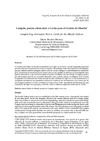Please use this identifier to cite or link to this item:
https://accedacris.ulpgc.es/jspui/handle/10553/70259
| Title: | Lampón, puerto alternativo a Cavite para el Galeón de Manila | Other Titles: | Lampón Bay, alternative Port to Cavite for the Manila Galleon | Authors: | Baudot Monroy, María | UNESCO Clasification: | 55 Historia | Keywords: | Galeón de Manila Puerto de Lampón Siglos XVII Siglos XVIII Manila Galleons, et al |
Issue Date: | 2020 | Journal: | Vegueta: Anuario de la Facultad de Geografía e Historia | Abstract: | La Carrera del Galeón de Manila se estableció en el siglo xvi en torno a un eje transpacífico formado por dos cabeceras: los puertos de Cavite y Acapulco. Sin embargo, hubo otros puertos en las Filipinas, que por distintos motivos (refugios ante el acoso de navíos enemigos o ante inclemencias meteorológicas, abundancia de maderas para la construcción naval), también se utilizaron ocasionalmente como puertos alternativos y que son escasamente conocidos. El objetivo de este artículo es explicar cómo y por qué Lampón pasó de ser un puerto alternativo más a puerto cabecera en Filipinas de la Carrera transpacífica en sustitución de Cavite durante los años centrales del siglo XVII. La documentación y la cartografía encontradas nos permitirán analizar los contextos, las circunstancias y las causas por las que Lampón sustituyó a Cavite y el tiempo en el que estuvo activo. Igualmente estudiaremos por qué a mediados del siglo XVIII se propuso, sin éxito, volver a utilizar Lampón en sustitución de Cavite. The Manila Galleon trade route was established in the 16th century across a transpacific axis formed by two main ports: Cavite and Acapulco. However, for various reasons (such as to escape enemy ships, bad weather or abundance of wood for shipbuilding), other less well-known ports in the Philippines were also occasionally used as alternatives. The goal of this article is to explain how and why Lampón went from being an alternative to be the chief Philippine port in the transpacific trade route, replacing Cavite during the middle of the 17th century. The documentation and cartography available allow us to analyse the contexts, circumstances and causes behind Cavite’s substitution by Lampón and the period during which the latter was active. In addition, we examine why, in the mid-18th century, Lampón was once again (albeit unsuccessfully) proposed as a replacement for Cavite. |
URI: | https://accedacris.ulpgc.es/handle/10553/70259 | ISSN: | 1133-598X | Source: | Vegueta: Anuario de la Facultad de Geografía e Historia [eISSN: 2341-1112], n. 20, p. 21-48 |
| Appears in Collections: | Artículos |
Page view(s)
104
checked on May 5, 2024
Download(s)
188
checked on May 5, 2024
Google ScholarTM
Check
Share
Export metadata
Items in accedaCRIS are protected by copyright, with all rights reserved, unless otherwise indicated.
